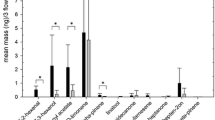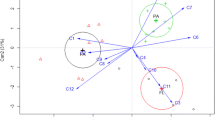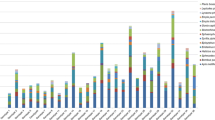Abstract
False blister beetles of the genus Oedemera (Coleoptera: Oedemeridae) are known as generalist pollinators of many plant species, but their mutualistic interactions are still insufficiently explored. The aim of the study was to identify the floral compounds emitted by sympatric and simultaneously co-flowering strawberry species that could serve for Oedemera beetles as olfactory cues of suitable flowers. In the test locality, flowers of Fragaria vesca and Fragaria viridis were visited by Oedemera lurida and Oedemera virescens beetles. O. lurida preferred flowers of F. viridis to those of F. vesca, whereas O. virescens tended to prefer F. vesca to F. viridis. GC-EAD analysis revealed that O. lurida perceived three compounds of F. vesca and four compounds of F. viridis flowers. Among these, nonanal, 2-phenylacetaldehyde and an unidentified compound (UC1) were common to both strawberries, while the amount of one compound (1,4-dimethoxybenzene) required to elicit an EAG response was sufficient in F. viridis, but not in F. vesca. Our results suggest that O. lurida are capable of choosing between flowers of the two strawberries based on VOCs’ with 1,4-dimethoxybenzene as a relevant key component. O. virescens responded to eight compounds present in F. vesca flowers. The flowers contained three compounds EAG-active towards O. lurida and O. virescens (nonanal, 2-phenylacetaldehyde, UC1) and five compounds EAG-active towards O. virescens only (acetic acid, decanal, (E)-non-2-enal, linalool, and UC2). In F. vesca and F. viridis flower extracts as well as headspaces, the identified compounds differed qualitatively only. (E)-Non-2-enal and acetic acid were recorded for the first time in Fragaria. Local specialization of Oedemera beetles in flower visiting was proved and relevant VOCs were identified.


Similar content being viewed by others
References
Andersson S, Dobson HEM (2003) Antennal responses to floral scents in the butterfly Heliconius melpomene. J Chem Ecol 29:2319–2330. https://doi.org/10.1023/A:1026278531806
Andersson S, Nilsson LA, Groth I, Bergström G (2002) Floral scents in butterfly-pollinated plants: possible convergence in chemical composition. Bot J Linn Soc 140:129–153. https://doi.org/10.1046/j.1095-8339.2002.00068.x
Armengol GF (2015) Biotic and abiotic factors that determine the emission of volatile organic compounds by flowers. PhD thesis, Universitat Autònoma de Barcelona. https://ddd.uab.cat/pub/tesis/2015/hdl_10803_288049/gfa1de1.pdf
Ashman T-L, Bradburn M, Cole DH, Blaney BH, Raguso RA (2005) The scent of a male: the role of floral volatiles in pollination of a gender dimorphic plant. Ecology 86:2099–2105. https://doi.org/10.1890/04-1161
Atanassova J, Sivilov O (2014) Pollen analysis of the crop contents of adult Oedemeridae (Coleoptera) in Bulgaria. Eur J Entomol 111:588–593. https://doi.org/10.14411/eje.2014.068
Bernhardt P (2000) Convergent evolution and adaptive radiation of beetle-pollinated angiosperms. Plant Syst Evol 222:293–320. https://doi.org/10.1007/BF00984108
Blažytė-Čereškienė L, Būda V, Bagdonaitė E (2012) Three wild Lithuanian strawberry species and their pollinators. Plant Syst Evol 298:819–826. https://doi.org/10.1007/s00606-012-0593-9
Burger H, Dötterl S, Ayasse M, Haberlein CM, Schulz S (2012) An arthropod deterrent attracts specialised bees to their host plants. Oecologia 168:727–736. https://doi.org/10.1007/s00442-011-2136-4
Carloni S, Bologna M (2005) Niche differences in two Oedemera species in mediterranean and continental ecosystems of central Italy (Coleoptera: Oedemeridae). Entomol Gener 28:201–211. https://doi.org/10.1127/entom.gen/28/2005/201
Carvalho AT, Dötterl S, Schlindwein C (2014) An aromatic volatile attracts oligolectic bee pollinators in an interdependent bee-plant relationship. J Chem Ecol 40:1126–1134. https://doi.org/10.1007/s10886-014-0510-5
Cook SM, Bartlet E, Murray DA, Williams IH (2002) The role of pollen odour in the attraction of pollen beetles to oilseed rape flowers. Entomol Exp Appl 104:43–50. https://doi.org/10.1046/j.1570-7458.2002.00989.x
Council of Europe (1996) European Pharmacopoeia, 3rd edn. Council of Europe, Strasbourg Cedex
Dobson HEM (2006) Relationship between floral fragrance composition and type of pollinator. In: Dudareva N, Pichersky E (eds) Biology of floral scent. Taylor and Francis, Boca Raton, pp 147–198
Dötterl S, Vereecken NJ (2010) The chemical ecology and evolution of bee-flower interactions: a review and perspectives. Can J Zool 88:668–697. https://doi.org/10.1139/Z10-031
Ervik F, Knudsen JT (2003) Water lilies and scarabs: faithful partners for 100 million years? Biol J Linn Soc 80:539–543. https://doi.org/10.1046/j.1095-8312.2003.00258.x
Farré-Armengol G, Filella I, Llusià J, Peñuelas J (2015) Pollination mode determines floral scent. Biochem Syst Ecol 61:44e53. https://doi.org/10.1016/j.bse.2015.05.007
Guédot C, Landolt PJ, Smithhisler C (2008) Odorants of the flowers of Butterfly Bush, Buddleia davidii Franch., as possible attractants of pest species of moths. Fla Entomol 91:576–582. https://doi.org/10.1653/0015-4040-91.4.576
Johnson SD, Ellis A, Dötterl B (2007) Specialization for pollination by beetles and wasps: the role of lollipop hairs and fragrance in Satyrium microrrhynchum (Orchidaceae). Am J Bot 94:47–55. https://doi.org/10.3732/ajb.94.1.47
Jürgens A, Dötterl S, Liede-Schumann S, Meve U (2010) Floral scent composition in early diverging taxa of Asclepiadoideae, and Secamonoideae (Apocynaceae). S Afr J Bot 76:749–761. https://doi.org/10.1016/j.sajb.2010.08.013
Klatt BK, Burmeister C, Westphal C, Tscharntke T, von Fragstein M (2013) Flower volatiles, crop varieties and bee responses. PLoS ONE 8(8):e72724. https://doi.org/10.1371/journal.pone.0072724
Knudsen JT, Eriksson R, Gershenzon J, Stahl B (2006) Diversity and distribution of floral scent. Bot Rev 72:1–120
Kunin WE (1992) Density and reproductive success in wild populations of Diplotaxis erucoides (Brassicaceae). Oecologia 91:129–133. https://doi.org/10.1007/BF00317251
Labokas J, Bagdonaitė E (2005) Phenotypic diversity of wild Fragaria vesca and F. viridis in Lithuania. Biologija 3:19–22
Maia ACD, Dötterl S, Kaiser R, Silberbauer-Gottsberger I, Teichert H, Gibernau M, do Amaral Ferraz Navarro DM, Schlindwein C, Gottsberger G (2012) The key role of 4-methyl-5-vinylthiazole in the attraction of scarab beetle pollinators: a unique olfactory floral signal shared by Annonaceae and Araceae. J Chem Ecol 38:1072–1080. https://doi.org/10.1007/s10886-012-0173-z
Majetic CJ, Raguso RA, Ashman TL (2009) Sources of floral scent variation. Can environment define floral scent phenotype? Plant Signal Behav 4:129–131
Martinková Z, Skuhrovec J, Barták M, Bezděk J, Bogusch P, Hadrava J, Hájek J, Janšta P, Jelínek J, Kubáň V, Štys P (2015) Role of host plant in determining the insect community associated with the flowers of dicotyledoneous herbaceous plants. Acta Soc Zool Bohem 79:95–104
Milet-Pinheiro P, Ayasse M, Dobson HEM, Schlindwein C, Francke W, Dötterl S (2013) The chemical basis of host-plant recognition in a specialized bee pollinator. J Chem Ecol 39:1347–1360. https://doi.org/10.1007/s10886-013-0363-3
Najda A, Dyduch M (2009) Contents and chemical composition of essential oils from wild strawberry (Fragaria vesca L.). J Herba Pol 55:153–162
Plepys D, Ibarra F, Francke W, Lofstedt C (2002) Odour-mediated nectar foraging in the silver Y moth, Autographa gamma (Lepidoptera: noctuidae): Behavioural and electrophysiological responses to floral volatiles. Oikos 99:75–82. https://doi.org/10.1034/j.1600-0706.2002.990108.x
Shimoda T, Nishihara M, Ozawa R, Takabayashi J, Arimura G (2012) The effect of genetically enriched (E)-b-ocimene and the role of floral scent in the attraction of the predatory mite Phytoseiulus persimilis to spider mite-induced volatile blends of torenia. New Phytol 193:1009–1021. https://doi.org/10.1111/j.1469-8137.2011.04018.x
Sivilov O, Atanassova J, Zlatkov B (2011) Food plant spectrum of Oedemeridae species (Insecta, Coleoptera) based on pollen analysis (A preliminary study). C R Acad Bulgare Sci 64:225–230
Soler C, Hossaert-McKey M, Buatois B, Bessière JM, Schatz B, Proffit M (2011) Geographic variation in floral scent in a highly specialized pollination mutualism. Phytochemistry 72:74–81. https://doi.org/10.1016/j.phytochem.2010.10.012
Steenhuisen SL, Jürgens A, Johnson SD (2013) Effects of volatile compounds emitted by Protea species (Proteaceae) on antennal electrophysiological responses and attraction of cetoniine beetles. J Chem Ecol 39:438–446. https://doi.org/10.1007/s10886-013-0259-2
Svensson GP, Hickman MOJr, Bartram S, Boland W, Pellmyr O, Raguso RA (2005) Chemistry and geographic variation of floral scent in Yucca filamentosa (Agavaceae). Am J Bot 92:1624–1631. https://doi.org/10.3732/ajb.92.10.1624
Theis N, Adler LS (2012) Advertising to the enemy: enhanced floral fragrance increases beetle attraction and reduces plant reproduction. Ecology 93:430–435. https://doi.org/10.1890/11-0825.1
Vazquez XA (2002) European Fauna of Oedemeridae. Argania Editio, Barcelona
Ventura MU, Pereira T, Nunes DH, Arruda IC (2007) Attraction of Astylus variegatus (Germ.) (Coleoptera, Melyridae) by volatile floral attractants. Sci Agric 64:306–307. https://doi.org/10.1590/S0103-90162007000300016
Vuts J, Imrei Z, Birkett MA, Pickett JA, Woodcock CM, Tóth M (2014) Semiochemistry of the Scarabaeoidea. J Chem Ecol 40:190–210. https://doi.org/10.1007/s10886-014-0377-5
Wibe A, Borg-Karlson AK, Cross J, Bichão H, Fountain M, Liblikas I, Sigsgaard L (2014) Combining 1,4-dimethoxybenzene, the major flower volatile of wild strawberry Fragaria vesca, with the aggregation pheromone of the strawberry blossom weevil Anthonomus rubi improves attraction. Crop Prot 64:122–128. https://doi.org/10.1016/j.cropro.2014.06.016
Willmer P (2011) Pollination and floral ecology. Princeton University Press, Princeton
Acknowledgements
We thank the expert entomologist Dr Romas Ferenca from the Tadas Ivanauskas Museum of Zoology, Lithuania for the identification of beetle species, as well as Mrs Laima Monkienė for the English text correction. Open Access to the research infrastructure of the Nature Research Centre under Lithuanian open access network initiative is acknowledged.
Author information
Authors and Affiliations
Corresponding author
Additional information
Handling Editor: Anna-Karin Borg-Karlson.
Publisher's Note
Springer Nature remains neutral with regard to jurisdictional claims in published maps and institutional affiliations.
Rights and permissions
About this article
Cite this article
Blažytė-Čereškienė, L., Apšegaitė, V. & Būda, V. The choice between flowers of closely related plant species by generalist pollinator: identification of relevant VOCs. Arthropod-Plant Interactions 13, 735–743 (2019). https://doi.org/10.1007/s11829-019-09702-2
Received:
Accepted:
Published:
Issue Date:
DOI: https://doi.org/10.1007/s11829-019-09702-2




